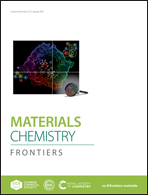Controlled chemical assembly of enzymes in cell lysate enabled by genetic-encoded nonstandard amino acids†
Abstract
Enzyme proteins are nanometer-sized molecules with a three-dimensional structure that can be manipulated and assembled into highly ordered nanostructures, which allows access to advanced biological materials. Here, genetically encoded nonstandard amino acids were used to induce and control the covalent assembly of enzyme protein molecules to prepare banded and cyclic assemblies using cell lysates. An aldehyde ketone reductase (AKR) was used as a model protein and incorporated with two p-azido-L-phenylalanine (pAzF) molecules, and then assembled into a band and ring using cell lysate and the assistance of microwaves. The obtained enzyme protein assemblies were characterized by MALDI-TOF MS, CLSM, AFM, etc., and their activities and stability were examined carefully. The results indicated that the location of mutant sites, protein concentration in the cell lysate supernatant and crosslinker amount played important roles in cyclic assembly. Furthermore, the control of the assembly morphology by the mutant site location is mainly determined by the spatial distance between sites. Additionally, the resultant protein rings demonstrated robust activity and stability against heating and digesting in the mimic intestinal fluid environment. Thus, by regulating the mutation sites and lysate content, the assembled proteins show unique morphological diversity that ranges from a band to a ring, suggesting an attractive platform for producing robust biocatalysis and stable biomaterials from ordered protein assembly.



 Please wait while we load your content...
Please wait while we load your content...